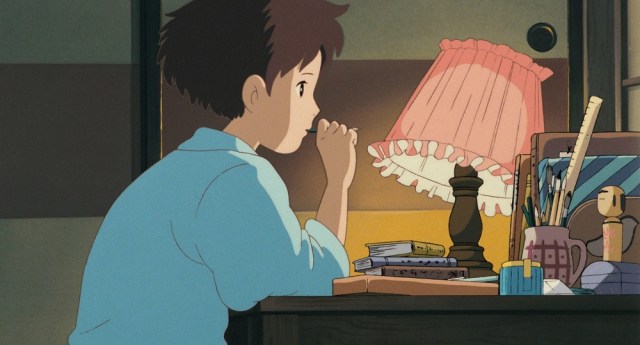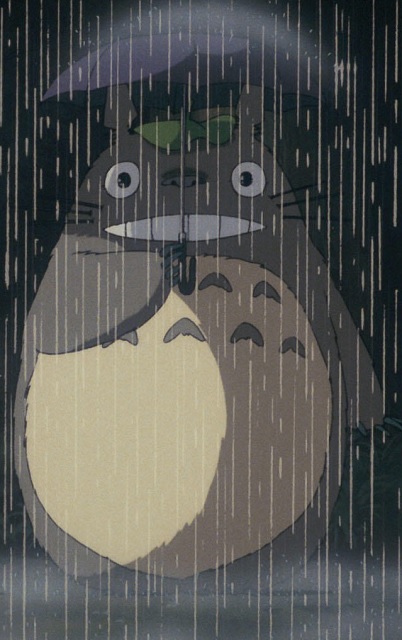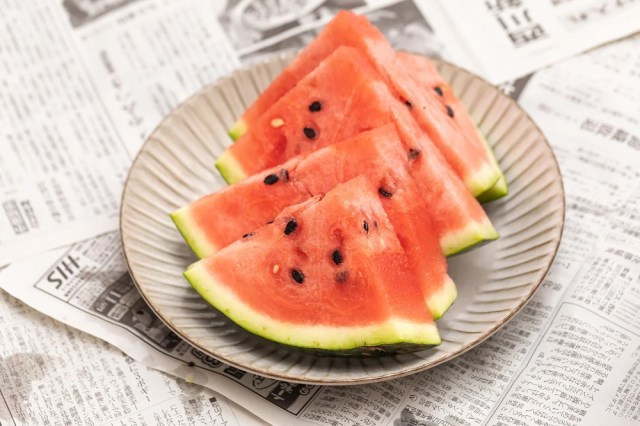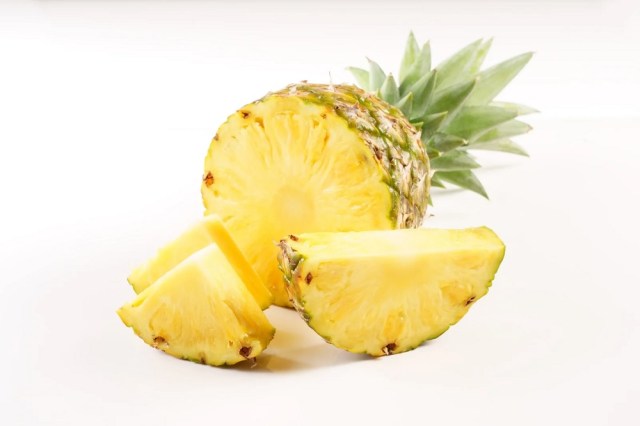
They do things a little differently at Studio Ghibli. Given the feast or famine realities of life in the anime industry, many production houses take on as many projects as they can, but part of the philosophy behind Ghibli’s founding was that if the staff felt like making something, they would, and if they didn’t, they wouldn’t. That’s not to say Ghibli’s animators don’t give maximum effort though, which the higher-ups recognize and reward with weekly massages on Saturdays.
Ghibli’s uniqueness isn’t limited to its artistic ideologies and rub-down policies, though. Its interview process for new animators is pretty unorthodox, too, with applicants being asked to complete such tasks as sharpening pencils and slicing up watermelons.
As part of his biannual interview series, media personality Hideyuki Nakamura recently spoke with Hiromasa Yonebayashi, the director of Studio Ghibli’s newest film, When Marnie Was There. The 41-year-old Yonebayashi, who made his directorial debut with 2010’s Arrietty, said that for as long as he can remember, he’s enjoyed drawing. Given his line of work, that’s not unusual, nor is the fact that he’s enjoyed reading comics since he was a young kid. What is surprising, though, are Yonebayashi’s specific manga preferences.
“I’ve always read shojo manga, even when I was growing up,” Yonebayashi recalls, referring to the subset of Japanese comics written for girls. “I didn’t read Fist of the North Star, but I read Tokimeki Tonight.”
In all fairness, Fist of the North Star’s martial arts-based people-exploding action and Tokimeki Tonight’s monster-based romance hijinks are both entertaining in their own ways.
“In shojo manga, there are many delicate, cute girls, and I tried to imitate that style of art in my drawings,” says Yonebayashi, who would often create his own manga which he would then show to his family and classmates. It wasn’t until he was in college, though, that he thought about pursuing a career in animation. “As a part-time job, I worked on an animated regional promotion commercial. It was the first time I saw my drawings move, and that was something I thought was really interesting when I saw the finished product.”
Although he submitted applications to numerous studios, Yonebayashi only heard back from Ghibli and one other outfit. He recalls that he initially had to submit two sample of his artwork, and Ghibli was impressed by them enough that he was called into the offices for a test. He did well enough that he was called in for a final interview, and like at many companies in Japan, there was more than one interviewer in the room with Yonebayashi. But rather than just multiple representatives from the HR department, Yonebayashi found himself sitting face to face with Hayao Miyazaki and Toshio Suzuki, the most successful director and producer in the history of anime, and two of Studio Ghilbi’s three founders.
▼ We’d like to believe there was a third, anonymous interviewer dressed as Totoro who spent the entire conversation standing silently in the corner of the room.
We’re not sure if it’s due to the many years that have since passed or the nervousness he possibly felt from having the two luminaries lobbing questions at him, but Yonebayashi says he can’t remember what either Miyazaki or Suzuki asked him. He does remember something else that happened during the hiring process, though.
“As part of the test, they gave me a pencil and told me to sharpen it. Later, someone came and collected the pencil and the shavings.”
Old school animation fans may be nodding their heads in approval, perceiving this as a sign of how Ghibli values hand-drawn art over computer-generated visual effects. The thing is, though, Ghibli doesn’t give the pencil test to all applicants. “They ask different people to do different things,” Yonebayashi reveals. “Sometimes they ask them to cut a watermelon, and a few people end up cutting it into discs.”
▼ This photo isn’t from a Ghibli test, but the result is the same.
Wait a second, watermelon discs? How’re you supposed to eat those? Only a crazy person would slice it like that, and actually, that’s the whole point of the test. “It’s kind of their way of checking, ‘Do you know how to apply common sense?’” Yonebayashi concludes.
▼ Much like how during my RocketNews24 interview my eventual boss gave me a glass of pineapple juice, and I impressed him by not spilling it all over my lap.
Weird as it may initially seem, the quirky check is very much in keeping with the attitudes Ghibli is known for. The studio’s films are loved not just for their technical merit, but for the human element contained in each frame of its best scenes, whether in a character’s subtle movements, the motivations driving the plot, or the natural deliveries from the vocal cast. In order to produce something like that, Ghibli needs people who can not only draw, but who can understand how the human mind works and faces a challenge, whether it’s something as simple as sharpening a pencil or as epic as looking for a castle in the sky.
Source: Katsumoku, Livedoor News
Top image: Studio Ghibli
Insert images: Studio Ghibli, Pakutaso (1, 2)




 Ghibli producer provokes backlash for comment regarding abilities of women to direct anime
Ghibli producer provokes backlash for comment regarding abilities of women to direct anime Our take on Studio Ghibli’s newest anime, When Marnie Was There【Impressions】
Our take on Studio Ghibli’s newest anime, When Marnie Was There【Impressions】 Studio Ghibli is not Studio Goro – Hayao Miyazaki’s son denies being his father’s successor
Studio Ghibli is not Studio Goro – Hayao Miyazaki’s son denies being his father’s successor Poster for Ghibli’s new movie under fire … from the big guru himself!
Poster for Ghibli’s new movie under fire … from the big guru himself! SoraReview: Mary and the Witch’s Flower, the newest anime from Studio Ghibli director Yonebayashi
SoraReview: Mary and the Witch’s Flower, the newest anime from Studio Ghibli director Yonebayashi McDonald’s new Happy Meals offer up cute and practical Sanrio lifestyle goods
McDonald’s new Happy Meals offer up cute and practical Sanrio lifestyle goods All-you-can-drink Starbucks and amazing views part of Tokyo’s new 170 meter-high sky lounge
All-you-can-drink Starbucks and amazing views part of Tokyo’s new 170 meter-high sky lounge Studio Ghibli glasses cases let anime characters keep an eye on your spectacles
Studio Ghibli glasses cases let anime characters keep an eye on your spectacles Kyoto’s 100 Demons yokai monster parade returns!
Kyoto’s 100 Demons yokai monster parade returns! Super Nintendo World expansion gets delayed for several months at Universal Studios Japan
Super Nintendo World expansion gets delayed for several months at Universal Studios Japan Arrest proves a common Japanese saying about apologies and police
Arrest proves a common Japanese saying about apologies and police Beautiful Sailor Moon manhole cover coasters being given out for free by Tokyo tourist center
Beautiful Sailor Moon manhole cover coasters being given out for free by Tokyo tourist center More foreign tourists than ever before in history visited Japan last month
More foreign tourists than ever before in history visited Japan last month The oldest tunnel in Japan is believed to be haunted, and strange things happen when we go there
The oldest tunnel in Japan is believed to be haunted, and strange things happen when we go there Princesses, fruits, and blacksmiths: Study reveals the 30 most unusual family names in Japan
Princesses, fruits, and blacksmiths: Study reveals the 30 most unusual family names in Japan Disney princesses get official manga makeovers for Manga Princess Cafe opening in Tokyo
Disney princesses get official manga makeovers for Manga Princess Cafe opening in Tokyo Starbucks reopens at Shibuya Scramble Crossing with new look and design concept
Starbucks reopens at Shibuya Scramble Crossing with new look and design concept Beautiful new Final Fantasy T-shirt collection on the way from Uniqlo【Photos】
Beautiful new Final Fantasy T-shirt collection on the way from Uniqlo【Photos】 Is the new Shinkansen Train Desk ticket worth it?
Is the new Shinkansen Train Desk ticket worth it? Foreign English teachers in Japan pick their favorite Japanese-language phrases【Survey】
Foreign English teachers in Japan pick their favorite Japanese-language phrases【Survey】 Japanese convenience store packs a whole bento into an onigiri rice ball
Japanese convenience store packs a whole bento into an onigiri rice ball We try out “Chan Ramen”, an underground type of ramen popular in the ramen community
We try out “Chan Ramen”, an underground type of ramen popular in the ramen community Studio Ghibli releases Kiki’s Delivery Service chocolate cake pouches in Japan
Studio Ghibli releases Kiki’s Delivery Service chocolate cake pouches in Japan Japan’s bone-breaking and record-breaking roller coaster is permanently shutting down
Japan’s bone-breaking and record-breaking roller coaster is permanently shutting down New definition of “Japanese whiskey” goes into effect to prevent fakes from fooling overseas buyers
New definition of “Japanese whiskey” goes into effect to prevent fakes from fooling overseas buyers Our Japanese reporter visits Costco in the U.S., finds super American and very Japanese things
Our Japanese reporter visits Costco in the U.S., finds super American and very Japanese things Studio Ghibli unveils Mother’s Day gift set that captures the love in My Neighbour Totoro
Studio Ghibli unveils Mother’s Day gift set that captures the love in My Neighbour Totoro Foreign passenger shoves conductor on one of the last full runs for Japan’s Thunderbird train
Foreign passenger shoves conductor on one of the last full runs for Japan’s Thunderbird train Domino’s Japan now sells…pizza ears?
Domino’s Japan now sells…pizza ears? New Japanese KitKat flavour stars Sanrio characters, including Hello Kitty
New Japanese KitKat flavour stars Sanrio characters, including Hello Kitty Kyoto creates new for-tourist buses to address overtourism with higher prices, faster rides
Kyoto creates new for-tourist buses to address overtourism with higher prices, faster rides Sales of Japan’s most convenient train ticket/shopping payment cards suspended indefinitely
Sales of Japan’s most convenient train ticket/shopping payment cards suspended indefinitely Sold-out Studio Ghibli desktop humidifiers are back so Totoro can help you through the dry season
Sold-out Studio Ghibli desktop humidifiers are back so Totoro can help you through the dry season Japanese government to make first change to romanization spelling rules since the 1950s
Japanese government to make first change to romanization spelling rules since the 1950s Ghibli founders Toshio Suzuki and Hayao Miyazaki contribute to Japanese whisky Totoro label design
Ghibli founders Toshio Suzuki and Hayao Miyazaki contribute to Japanese whisky Totoro label design Doraemon found buried at sea as scene from 1993 anime becomes real life【Photos】
Doraemon found buried at sea as scene from 1993 anime becomes real life【Photos】 Tokyo’s most famous Starbucks is closed
Tokyo’s most famous Starbucks is closed One Piece characters’ nationalities revealed, but fans have mixed opinions
One Piece characters’ nationalities revealed, but fans have mixed opinions We asked a Uniqlo employee what four things we should buy and their suggestions didn’t disappoint
We asked a Uniqlo employee what four things we should buy and their suggestions didn’t disappoint Producer clarifies Studio Ghibli’s future, mentions that Miyazaki “would like to make an anime”
Producer clarifies Studio Ghibli’s future, mentions that Miyazaki “would like to make an anime” Hayao Miyazaki spends retirement from anime by…spending every day at his animation studio
Hayao Miyazaki spends retirement from anime by…spending every day at his animation studio Beardless Hayao Miyazaki has on-brand answer to what he likes about The Boy and the Heron【Video】
Beardless Hayao Miyazaki has on-brand answer to what he likes about The Boy and the Heron【Video】 It’s good to have problems, Hayao Miyazaki tells Studio Ghibli staff
It’s good to have problems, Hayao Miyazaki tells Studio Ghibli staff Hayao Miyazaki still looking for talented staff to join Studio Ghibli for new anime production
Hayao Miyazaki still looking for talented staff to join Studio Ghibli for new anime production Hayao Miyazaki is getting worried about how his new anime is being marketed, Ghibli producer says
Hayao Miyazaki is getting worried about how his new anime is being marketed, Ghibli producer says Hayao Miyazaki makes rare video appearance to check out Ghibli Museum’s revamped cafe【Video】
Hayao Miyazaki makes rare video appearance to check out Ghibli Museum’s revamped cafe【Video】 “I didn’t ask the old men for any advice” says director of Studio Ghibli’s first CG anime
“I didn’t ask the old men for any advice” says director of Studio Ghibli’s first CG anime Even Spirited Away’s Yubaba wants you to wear a mask for coronavirus safety
Even Spirited Away’s Yubaba wants you to wear a mask for coronavirus safety Hayao Miyazaki was offended by the idea that he should work in live-action, interview shows
Hayao Miyazaki was offended by the idea that he should work in live-action, interview shows 10 best Studio Ghibli anime, as picked by Japanese fans– Different ages have different answers
10 best Studio Ghibli anime, as picked by Japanese fans– Different ages have different answers “Let’s leave it to Goro” – The moment Hayao Miyazaki was truly convinced about Ghibli theme park
“Let’s leave it to Goro” – The moment Hayao Miyazaki was truly convinced about Ghibli theme park Studio Ghibli co-founder Toshio Suzuki receives lifetime achievement honor at Annie awards
Studio Ghibli co-founder Toshio Suzuki receives lifetime achievement honor at Annie awards Hayao Miyazaki’s The Boy and the Heron nominated for Academy Award
Hayao Miyazaki’s The Boy and the Heron nominated for Academy Award Hayao Miyazaki appears without his trademark beard, looks like a different person【Video】
Hayao Miyazaki appears without his trademark beard, looks like a different person【Video】
Leave a Reply